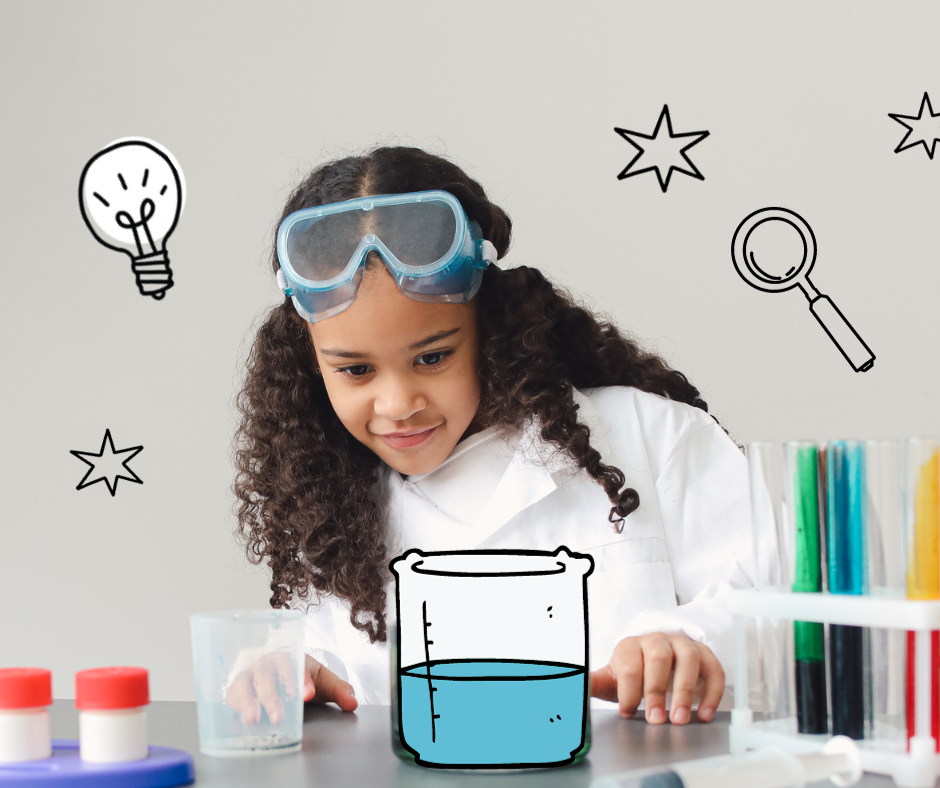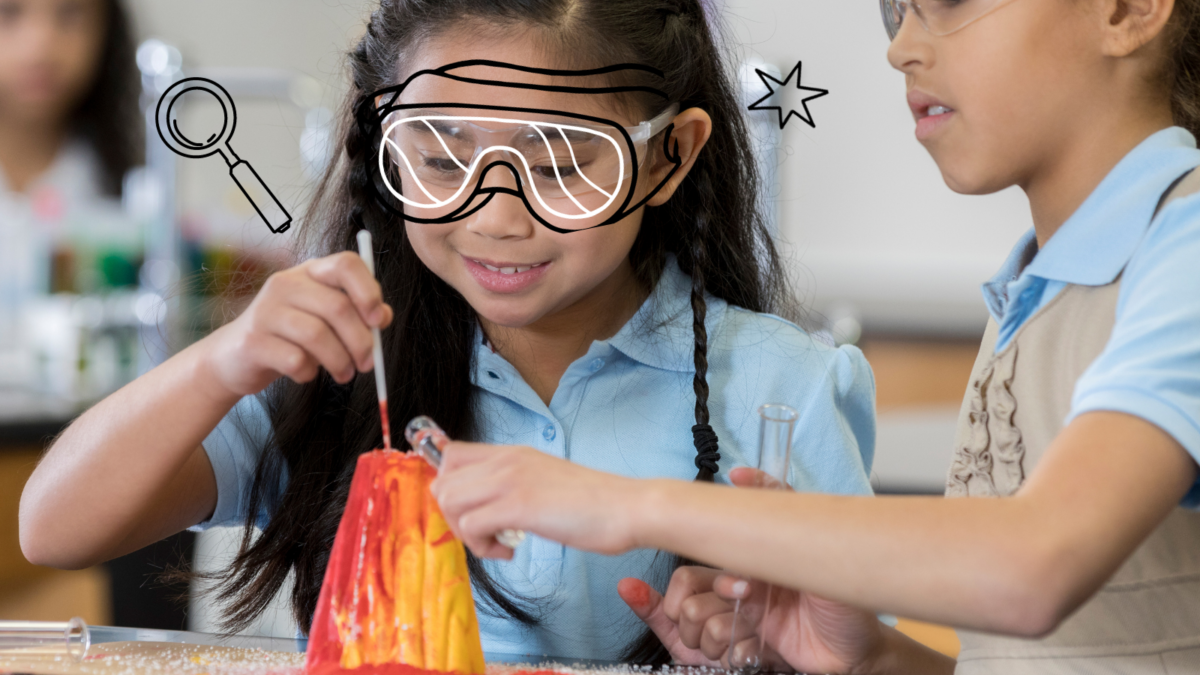Thinking Like a Scientist
At Tinkercast, we believe that podcasts tap into kids’ natural curiosity, helping them discover all the wow in the world. TinkerClass takes that a step further, combining podcasts with projects to create podjects, which can help educators encourage students to “think like a scientist.” But how?? When students are encouraged to “think like a scientist,” what it really means is to get curious and ask questions about what’s happening. Thinking like a scientist actually promotes curiosity, creativity, and fun – all things we love here at Tinkercast! Let’s look closer at what it means to think like a scientist and why it’s important for students.
WOW
The first step of the scientific method is to make an observation or take in information. At Tinkercast, we like to call these WOWs . The most important factor in making observations is taking notice. In a world with lots of things fighting for our attention it can be hard to pause and observe our surroundings. For children to develop their observational skills, it’s crucial for them to take time to notice their environment. Fortunately, children often do this instinctively! When a student shares something that has WOW’d them, join in the WOW with phrases like “I agree, that’s amazing!” or “How cool! What a great observation!”. Additionally, you can foster moments of observation by prompting students to pause for five minutes and look around them . What colors do you see? What do you hear? Is there any movement? Is there anything that makes you say WOW?
Another term for talking about these observations is phenomena.
Next Generation Science Standards (NGSS) defines natural phenomena as:

“observable events that occur in the universe and that we can use our science knowledge to explain or predict.”
When you incorporate WOW into your teaching, you’re tapping into student’s interests – what WOW’d them – and then guiding them to get curious about their Wow. The result is students are more engaged in the topic. Phenomena, and WOWs, do not have to be big and flashy. They can be as simple as noticing the dew on a spider web or hearing an interesting fact on an episode of Wow in the World.
Check out TinkerClass’s WOWS and WONDERS worksheet where your students can record what made them WOW.
Curiosity
The next step in the scientific process is asking questions, or in other words, being curious. Often, kids are naturally great at asking questions and are full of “why” statements.
The beauty of being an educator is nurturing that curiosity and inspiring students to delve deeper. Fostering an inquiry mindset is integral to cultivating curiosity.
As an educator, you can foster curiosity by modeling question-asking and showing interest when your students ask questions.
There are many benefits to cultivating a curious student. As articulated by NGSS, “It is the phenomenon plus the student-generated questions about the phenomenon that guides the learning and teaching. The practice of asking questions or identifying problems becomes a critical part of trying to figure something out.” A study by Dr. Matthias Gruber and associates demonstrated that once students’ curiosity was peaked, they were better at learning and retaining information. The research also indicated that curiosity heightened activity in the brain region associated with reward and pleasure. In other words, curiosity can make learning more rewarding!

Prompt your students to ask questions about their observations and write them down.
Wonder
After you have a Wow and you’ve observed and gotten curious, the next step is to form your hypothesis – which TinkerClass calls the “Big Wonder”! A Big Wonder might start with “What would happen if…” or “How would this affect…”.
Research has shown that inquiry-based learning can lead to greater academic outcomes for students. A 2021 study of 5th grade students found that inquiry-based techniques increase student achievement in science. It’s important that the process of forming Big Wonders be student-led. The question should resonate with them, evoking relatability and excitement. As emphasized by NGSS, “[Students] get interested in and identify with science as a way of understanding and improving real world contexts. Focusing investigations on compelling phenomena can help sustain students’ science learning.” This article by Amplify suggests three ways to cultivating an inquiry-based learning:

(1) “Cultivate an inquiry mindset.” Shift the focus from asking for answers to asking students to think of questions.
(2) “Make inquiry visible.” What strategies can you use so students can see their thinking in process?
(3) “Build an inquiry environment.” How can you arrange your room or space to support conversation and questions rather than lecture?
Another great way to invoke inquiry-based learning is by listening to Wow in the World episodes! Have your students join in as Guy and Mindy model making observations, asking curious questions, and creating a Big Wonder – then have your students create some Big Wonders of their own!
Check out our Brainstorming Wonders worksheet and organize your thoughts with our Big Wonders worksheet.
Tinker
Now that we’ve been WOW’d, asked questions, and found our Big Wonder, there comes the temptation…to Google the answer. Answers are always at our fingertips. Your students, and you, may be asking: Why spend time experimenting and investigating when I can just look it up online? It’s a valid question, but there’s purpose to the process.
Testing the hypothesis, or tinkering, supports students in thinking critically about their ideas.

Critical thinking is vital for developing everyday skills such as decision-making, communicating, and perspective-taking. When we skip the learning process and go straight to the answer, students don’t strengthen critical thinking skills. This is especially important for young children with developing brains.
When students tinker, they are engaging in project-based learning (PBL) – or as we like to call it in TinkerClass podject-based learning! According to the Buck Institute for Education, Project Based Learning is “a teaching method in which students gain knowledge and skills by working for an extended period of time to investigate and respond to an authentic, engaging, and complex question, problem, or challenge.” A study examining the effectiveness of PBL in elementary science classes found that the students assigned to PBL classrooms outperformed their peers by 8%. Project-based learning promotes engagement, deeper learning, and creativity.
Learn more about podjects [podcasts + projects], a project-based learning approach where students turn their curiosity into experimentation!
Try Again!
Experimentation is risky. We can use the wrong ingredients or miss a step. Maybe we found out our hypothesis or Big Wonder was wrong. But failure is a key part of the scientific process. We can learn just as much from mistakes as we do when everything goes according to plan – maybe even more! Amy Edmonson, an expert in the study of failure, defines intelligent failure as “trying something new in pursuit of a worthy goal.” She argues that fear of failure can lead to avoiding risks, which diminishes opportunities to learn. Therefore, it’s important to develop a classroom culture that encourages taking healthy risks and normalizes, even celebrates, mistakes. As stated best by the beloved Ms. Frizzle, “Take chances, make mistakes, get messy!”
One way to create a fail-safe classroom environment is by promoting a “not yet” mentality with your students. For example:
“Our experiment didn’t produce the product we wanted…yet!”
“I haven’t found the answer to that question…yet!”
Say it until it’s class norm!
Failure is important to learning, but it’s also crucial for building resilience. Thinking like a scientist encourages students to try, fail, and try again. This process builds a growth mindset that embraces challenging tasks and creates a greater sense of accomplishment when a goal is reached or something new is learned. Through the scientific process, children learn that we don’t give up when something goes wrong, we take what we’ve learned and move forward!

Use our Improve Your Design worksheet to evaluate your experiment and our Re-Testing Plans worksheet to plan your re-tests!
Thinking like a scientist in the classroom and beyond
When you nurture a sense of wonder you not only help students thrive academically, you also help them build life skills for holistic success in and out of school. Students who think like a scientist are observant, curious, creative, and resilient!
Thinking like a scientist teaches us that it’s not about the answers, it’s about the journey and what we learn along the way!
Ready to help your students start thinking like a scientist? Sign up for TinkerClass.com for FREE today!